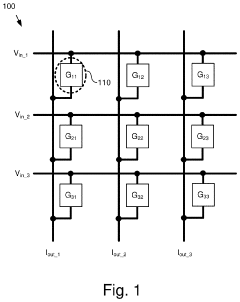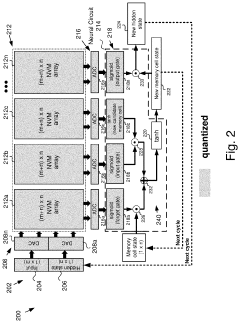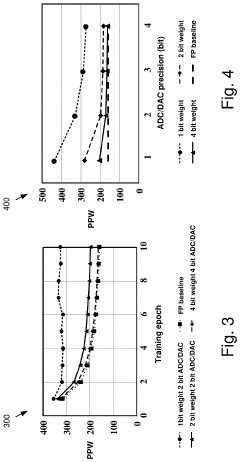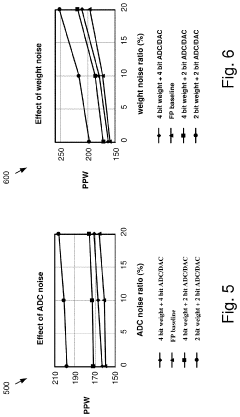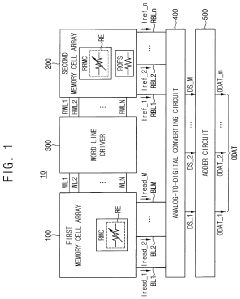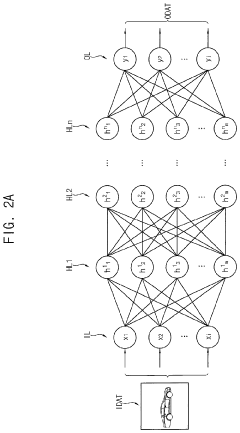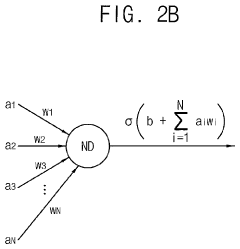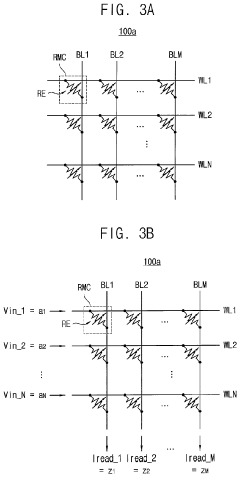How Neuromorphic Chips Facilitate Real-Time Computing Models
OCT 9, 20259 MIN READ
Generate Your Research Report Instantly with AI Agent
Patsnap Eureka helps you evaluate technical feasibility & market potential.
Neuromorphic Computing Evolution and Objectives
Neuromorphic computing represents a paradigm shift in computational architecture, drawing inspiration from the structure and function of the human brain. This approach emerged in the late 1980s when Carver Mead first introduced the concept of using electronic analog circuits to mimic neuro-biological architectures present in the nervous system. Since then, the field has evolved through several distinct phases, each marked by significant technological breakthroughs and expanding applications.
The initial phase focused primarily on theoretical foundations and basic circuit designs that could replicate neural behaviors. By the early 2000s, researchers had developed more sophisticated neuromorphic systems capable of implementing simple learning algorithms. The past decade has witnessed exponential growth in this field, driven by advances in materials science, integrated circuit design, and a deeper understanding of neural processes.
Current neuromorphic chips represent the convergence of multiple technologies: analog and digital circuit design, novel memory architectures like memristors, and sophisticated neural network algorithms. These chips are fundamentally different from traditional von Neumann architectures, as they integrate processing and memory in ways that eliminate the bottleneck found in conventional computing systems.
The primary objective of neuromorphic computing is to achieve brain-like efficiency in processing complex, unstructured data in real-time environments. While conventional processors excel at sequential, precise calculations, they struggle with the parallel, approximate, and adaptive processing that characterizes human cognition. Neuromorphic systems aim to bridge this gap by providing computational platforms that can process sensory data with minimal power consumption while maintaining real-time responsiveness.
Another critical goal is to enable edge computing capabilities for AI applications. As IoT devices proliferate and autonomous systems become more prevalent, the need for local, energy-efficient processing of sensory information becomes increasingly important. Neuromorphic chips offer a promising solution by bringing neural network processing directly to edge devices without requiring constant communication with cloud servers.
Looking forward, the field is trending toward more sophisticated integration of biological principles into silicon. This includes implementing spike-timing-dependent plasticity (STDP) and other learning mechanisms directly in hardware, creating systems capable of unsupervised learning and adaptation to new environments without explicit programming. The ultimate vision is to develop neuromorphic systems that can approach the human brain's remarkable efficiency—processing complex information while consuming only about 20 watts of power.
The initial phase focused primarily on theoretical foundations and basic circuit designs that could replicate neural behaviors. By the early 2000s, researchers had developed more sophisticated neuromorphic systems capable of implementing simple learning algorithms. The past decade has witnessed exponential growth in this field, driven by advances in materials science, integrated circuit design, and a deeper understanding of neural processes.
Current neuromorphic chips represent the convergence of multiple technologies: analog and digital circuit design, novel memory architectures like memristors, and sophisticated neural network algorithms. These chips are fundamentally different from traditional von Neumann architectures, as they integrate processing and memory in ways that eliminate the bottleneck found in conventional computing systems.
The primary objective of neuromorphic computing is to achieve brain-like efficiency in processing complex, unstructured data in real-time environments. While conventional processors excel at sequential, precise calculations, they struggle with the parallel, approximate, and adaptive processing that characterizes human cognition. Neuromorphic systems aim to bridge this gap by providing computational platforms that can process sensory data with minimal power consumption while maintaining real-time responsiveness.
Another critical goal is to enable edge computing capabilities for AI applications. As IoT devices proliferate and autonomous systems become more prevalent, the need for local, energy-efficient processing of sensory information becomes increasingly important. Neuromorphic chips offer a promising solution by bringing neural network processing directly to edge devices without requiring constant communication with cloud servers.
Looking forward, the field is trending toward more sophisticated integration of biological principles into silicon. This includes implementing spike-timing-dependent plasticity (STDP) and other learning mechanisms directly in hardware, creating systems capable of unsupervised learning and adaptation to new environments without explicit programming. The ultimate vision is to develop neuromorphic systems that can approach the human brain's remarkable efficiency—processing complex information while consuming only about 20 watts of power.
Market Demand for Real-Time AI Processing Solutions
The global market for real-time AI processing solutions is experiencing unprecedented growth, driven by the increasing demand for instantaneous data analysis and decision-making capabilities across various industries. Current projections indicate that the real-time AI processing market will reach $45 billion by 2027, with a compound annual growth rate of 29% from 2022. This remarkable expansion reflects the critical need for computing systems that can process complex AI workloads with minimal latency.
Healthcare represents one of the most promising sectors for real-time AI applications, particularly in patient monitoring systems, diagnostic imaging, and surgical robotics. Medical professionals require instantaneous analysis of patient data to make life-saving decisions, creating a substantial market for neuromorphic computing solutions that can process physiological signals and medical imagery with speed and efficiency comparable to the human brain.
The automotive industry has emerged as another significant driver of demand, with advanced driver-assistance systems (ADAS) and autonomous vehicles requiring real-time processing of sensor data from cameras, lidar, and radar. Market research indicates that automotive manufacturers are willing to invest heavily in neuromorphic computing technologies that can reduce the latency of perception systems from hundreds of milliseconds to single-digit milliseconds, enhancing safety and performance.
Industrial automation and smart manufacturing environments increasingly rely on real-time AI for quality control, predictive maintenance, and process optimization. The ability to analyze production line data instantaneously can prevent costly downtime and improve operational efficiency, with studies showing potential productivity improvements of up to 25% when implementing real-time AI processing solutions.
Edge computing applications represent a rapidly expanding market segment, with IoT devices generating massive volumes of data that must be processed locally to reduce bandwidth requirements and ensure privacy. Industry analysts predict that by 2025, over 75% of enterprise-generated data will be processed at the edge, creating substantial demand for energy-efficient neuromorphic chips capable of performing complex AI tasks without relying on cloud connectivity.
Consumer electronics manufacturers are also driving market growth, seeking to incorporate more sophisticated AI capabilities into smartphones, wearables, and smart home devices while maintaining battery life and thermal performance. The demand for voice assistants, real-time translation, and augmented reality applications that operate with imperceptible latency has created a lucrative market opportunity for neuromorphic computing solutions that can deliver human-like cognitive capabilities with significantly lower power consumption than traditional processors.
Healthcare represents one of the most promising sectors for real-time AI applications, particularly in patient monitoring systems, diagnostic imaging, and surgical robotics. Medical professionals require instantaneous analysis of patient data to make life-saving decisions, creating a substantial market for neuromorphic computing solutions that can process physiological signals and medical imagery with speed and efficiency comparable to the human brain.
The automotive industry has emerged as another significant driver of demand, with advanced driver-assistance systems (ADAS) and autonomous vehicles requiring real-time processing of sensor data from cameras, lidar, and radar. Market research indicates that automotive manufacturers are willing to invest heavily in neuromorphic computing technologies that can reduce the latency of perception systems from hundreds of milliseconds to single-digit milliseconds, enhancing safety and performance.
Industrial automation and smart manufacturing environments increasingly rely on real-time AI for quality control, predictive maintenance, and process optimization. The ability to analyze production line data instantaneously can prevent costly downtime and improve operational efficiency, with studies showing potential productivity improvements of up to 25% when implementing real-time AI processing solutions.
Edge computing applications represent a rapidly expanding market segment, with IoT devices generating massive volumes of data that must be processed locally to reduce bandwidth requirements and ensure privacy. Industry analysts predict that by 2025, over 75% of enterprise-generated data will be processed at the edge, creating substantial demand for energy-efficient neuromorphic chips capable of performing complex AI tasks without relying on cloud connectivity.
Consumer electronics manufacturers are also driving market growth, seeking to incorporate more sophisticated AI capabilities into smartphones, wearables, and smart home devices while maintaining battery life and thermal performance. The demand for voice assistants, real-time translation, and augmented reality applications that operate with imperceptible latency has created a lucrative market opportunity for neuromorphic computing solutions that can deliver human-like cognitive capabilities with significantly lower power consumption than traditional processors.
Neuromorphic Chip Technology Status and Barriers
Neuromorphic computing technology has made significant strides globally, yet faces substantial technical barriers that impede widespread adoption. Current neuromorphic chips demonstrate impressive capabilities in specific applications but remain limited in scalability and general-purpose computing. Leading implementations like IBM's TrueNorth, Intel's Loihi, and BrainChip's Akida have achieved notable energy efficiency improvements—often 100-1000x better than traditional computing architectures when handling neural network tasks—but struggle with programming complexity and integration challenges.
The fundamental technical barriers include hardware limitations in synapse density and neuron connectivity. While biological brains contain approximately 10^15 synapses, even advanced neuromorphic chips typically support only 10^6 to 10^8 synaptic connections, creating a significant gap in computational capacity. Additionally, current manufacturing processes face yield and reliability issues when scaling these complex architectures to higher densities.
Memory-processing integration presents another significant challenge. The von Neumann bottleneck remains partially unresolved in many neuromorphic designs, with data transfer between memory and processing units still creating performance limitations for real-time applications requiring rapid response capabilities.
Power efficiency, while improved compared to traditional architectures, remains insufficient for many mobile and edge computing scenarios. Current neuromorphic chips typically consume 10-100mW during operation, which exceeds the power budget for many IoT and wearable applications targeting sub-milliwatt operation.
Software ecosystem development lags significantly behind hardware advances. Programming models for neuromorphic computing remain highly specialized, requiring expertise in both neuroscience and computer engineering. The lack of standardized development tools, programming languages, and middleware creates substantial barriers to entry for developers and researchers seeking to leverage these architectures for real-time computing applications.
Geographically, neuromorphic research centers primarily in North America, Europe, and East Asia. The United States leads in commercial development through companies like Intel and IBM, while the European Union has established significant research initiatives through the Human Brain Project. China has recently accelerated investments in this field, particularly through universities and research institutes focusing on brain-inspired computing architectures.
Interoperability with existing computing infrastructure presents ongoing challenges, as neuromorphic systems often require specialized interfaces to communicate with conventional computing systems, limiting their integration into existing technology stacks and real-time processing pipelines.
The fundamental technical barriers include hardware limitations in synapse density and neuron connectivity. While biological brains contain approximately 10^15 synapses, even advanced neuromorphic chips typically support only 10^6 to 10^8 synaptic connections, creating a significant gap in computational capacity. Additionally, current manufacturing processes face yield and reliability issues when scaling these complex architectures to higher densities.
Memory-processing integration presents another significant challenge. The von Neumann bottleneck remains partially unresolved in many neuromorphic designs, with data transfer between memory and processing units still creating performance limitations for real-time applications requiring rapid response capabilities.
Power efficiency, while improved compared to traditional architectures, remains insufficient for many mobile and edge computing scenarios. Current neuromorphic chips typically consume 10-100mW during operation, which exceeds the power budget for many IoT and wearable applications targeting sub-milliwatt operation.
Software ecosystem development lags significantly behind hardware advances. Programming models for neuromorphic computing remain highly specialized, requiring expertise in both neuroscience and computer engineering. The lack of standardized development tools, programming languages, and middleware creates substantial barriers to entry for developers and researchers seeking to leverage these architectures for real-time computing applications.
Geographically, neuromorphic research centers primarily in North America, Europe, and East Asia. The United States leads in commercial development through companies like Intel and IBM, while the European Union has established significant research initiatives through the Human Brain Project. China has recently accelerated investments in this field, particularly through universities and research institutes focusing on brain-inspired computing architectures.
Interoperability with existing computing infrastructure presents ongoing challenges, as neuromorphic systems often require specialized interfaces to communicate with conventional computing systems, limiting their integration into existing technology stacks and real-time processing pipelines.
Current Neuromorphic Solutions for Real-Time Computing
01 Neuromorphic architecture for real-time processing
Neuromorphic chips are designed with architectures that mimic the human brain's neural networks, enabling efficient real-time processing of complex data. These architectures incorporate parallel processing capabilities and specialized neural circuits that can handle multiple inputs simultaneously, significantly reducing latency compared to traditional computing systems. This approach allows for faster decision-making and response times in applications requiring immediate feedback.- Neuromorphic architecture for real-time processing: Neuromorphic chips are designed with architectures that mimic the human brain's neural networks, enabling efficient real-time processing of complex data. These architectures incorporate parallel processing capabilities and specialized neural circuits that can handle multiple inputs simultaneously, significantly reducing latency compared to traditional computing systems. This approach allows for faster decision-making and response times in applications requiring immediate feedback.
- Energy-efficient computing for time-critical applications: Neuromorphic chips achieve energy efficiency while maintaining real-time computing capabilities through specialized hardware designs that minimize power consumption. These chips utilize event-driven processing and sparse activation patterns similar to biological neurons, consuming energy only when necessary. This efficiency makes them particularly suitable for time-critical applications in resource-constrained environments such as edge devices, autonomous vehicles, and IoT systems where both speed and power efficiency are crucial.
- Spike-based processing for temporal data analysis: Neuromorphic chips employ spike-based processing techniques that excel at analyzing temporal data in real-time. This approach uses discrete spikes or pulses to encode information, similar to how biological neurons communicate. The temporal precision of spike-based processing enables these chips to efficiently handle time-series data, detect patterns, and respond to dynamic changes in input signals. This capability is particularly valuable for applications like sensor fusion, motion detection, and speech recognition where timing relationships between signals are critical.
- On-chip learning and adaptation for real-time environments: Advanced neuromorphic chips incorporate on-chip learning capabilities that allow them to adapt to changing environments in real-time. These systems can modify their internal parameters and connection strengths based on incoming data, enabling continuous learning without requiring offline training. This adaptability makes them well-suited for dynamic environments where conditions may change unexpectedly, such as in robotics, autonomous navigation, and interactive systems that must respond to novel situations without human intervention.
- Integration with conventional computing systems for enhanced performance: Neuromorphic chips can be integrated with traditional computing architectures to create hybrid systems that leverage the strengths of both approaches. These integrated solutions combine the real-time processing capabilities of neuromorphic hardware with the precision and programmability of conventional processors. The resulting systems can handle complex computational tasks with improved speed and efficiency, particularly for applications requiring both symbolic and neural processing, such as advanced AI systems, complex control systems, and data analytics platforms that need to process information in real-time.
02 Spiking neural networks for energy-efficient computing
Spiking neural networks implemented in neuromorphic chips offer energy-efficient real-time computing by transmitting information through discrete events or spikes rather than continuous signals. This event-driven processing approach significantly reduces power consumption while maintaining high computational performance for real-time applications. The asynchronous nature of spike-based computation allows these systems to respond quickly to inputs while conserving energy when processing is not required.Expand Specific Solutions03 Memory-processing integration for reduced latency
Neuromorphic chips integrate memory and processing elements in close proximity, reducing the data transfer bottleneck that exists in conventional computing architectures. This integration enables faster access to stored information and reduces the latency associated with memory access operations. By placing memory elements directly alongside processing units, these chips can perform real-time computations with minimal delay, making them suitable for applications requiring immediate response times.Expand Specific Solutions04 Adaptive learning capabilities for dynamic environments
Neuromorphic chips incorporate adaptive learning mechanisms that allow them to continuously update their processing parameters based on incoming data. This capability enables real-time adaptation to changing environments and input conditions without requiring system retraining or reconfiguration. The on-chip learning capabilities facilitate immediate response to novel situations, making these systems particularly valuable for autonomous systems operating in unpredictable environments where real-time decision-making is critical.Expand Specific Solutions05 Edge computing implementation for distributed processing
Neuromorphic chips are increasingly deployed in edge computing scenarios, enabling real-time processing of data at or near the source of data generation. This distributed approach reduces the need to transmit large volumes of data to centralized servers, decreasing latency and enabling faster response times. By processing information locally on neuromorphic hardware, edge devices can make immediate decisions based on sensor inputs, supporting applications like autonomous vehicles, industrial automation, and smart infrastructure that require instantaneous computation.Expand Specific Solutions
Leading Companies in Neuromorphic Computing Ecosystem
Neuromorphic computing is currently in an early growth phase, with the market expected to expand significantly as real-time computing demands increase across industries. The global neuromorphic chip market, valued at approximately $3 billion, is projected to grow at a CAGR of 20-25% through 2030. Technology maturity varies among key players: IBM leads with its TrueNorth architecture, while Intel's Loihi chip demonstrates advanced capabilities. Syntiant and Samsung focus on edge AI applications, and academic-industry partnerships from institutions like Tsinghua University and Zhejiang University are accelerating innovation. Chinese companies like Beijing Lingxi Technology are emerging as significant competitors, particularly in brain-inspired computing systems. The field is characterized by rapid technological advancement but remains pre-standardization, with commercial applications still evolving.
SYNTIANT CORP
Technical Solution: Syntiant has developed the Neural Decision Processor (NDP), a specialized neuromorphic chip designed specifically for edge AI applications with a focus on always-on audio and sensor processing. Unlike traditional neuromorphic approaches that strictly mimic biological neurons, Syntiant's architecture is optimized for deep learning workloads while maintaining neuromorphic principles of co-located memory and processing. The NDP100 and NDP120 chips can process neural networks while consuming less than 1mW of power[5], enabling always-on keyword spotting and sensor fusion applications in battery-powered devices. Syntiant's architecture implements a dataflow design that minimizes data movement, with processing elements arranged to match the structure of deployed neural networks. This approach allows for extremely efficient inference of trained models, with the chip activating only the necessary components for each computation. The company has shipped over 20 million units as of 2022[6], demonstrating commercial viability in consumer electronics, particularly for voice-activated features in earbuds, smartphones, and IoT devices.
Strengths: Ultra-low power consumption (<1mW) enables always-on applications in battery-powered devices; proven commercial deployment with millions of units shipped; optimized for specific real-time audio and sensor processing tasks. Weaknesses: Less flexible than general-purpose neuromorphic chips; primarily focused on inference rather than on-chip learning; specialized for specific application domains rather than general neuromorphic computing.
International Business Machines Corp.
Technical Solution: IBM's TrueNorth neuromorphic chip represents one of the most significant advancements in neuromorphic computing. The chip contains 1 million digital neurons and 256 million synapses, organized into 4,096 neurosynaptic cores. TrueNorth implements a non-von Neumann architecture that collocates memory and processing, mimicking the brain's structure. The chip operates on an event-driven basis rather than clock-driven, activating only when neurons receive sufficient input to fire, which dramatically reduces power consumption to approximately 70mW during typical operation[1]. IBM has demonstrated TrueNorth's capabilities in real-time applications including object recognition, gesture recognition, and autonomous navigation, achieving classification accuracy comparable to traditional deep learning approaches while consuming significantly less power[2]. The architecture supports on-chip learning through spike-timing-dependent plasticity (STDP) mechanisms, allowing for adaptive computing models that can evolve in real-time environments.
Strengths: Extremely low power consumption (70mW) enables deployment in edge devices; event-driven architecture provides natural efficiency for sparse temporal data processing; high neuron/synapse density supports complex neural networks. Weaknesses: Digital implementation limits biological fidelity compared to analog approaches; programming complexity requires specialized knowledge; limited commercial deployment beyond research applications.
Core Innovations in Brain-Inspired Computing Hardware
Hardware Accelerated Discretized Neural Network
PatentActiveUS20210334338A1
Innovation
- A quantized neural network architecture that converts digital input and hidden state signals into analog form, processes them using non-volatile memory weight arrays for vector matrix multiplication, and then converts back to digital, with bit-widths reduced to 4 bits or less, utilizing DACs and ADCs to maintain performance comparable to 32-bit implementations.
Neuromorphic computing device and method of designing the same
PatentActiveUS11881260B2
Innovation
- Incorporating a second memory cell array with offset resistors connected in parallel, using the same resistive material as the first memory cell array, to convert read currents into digital signals, thereby mitigating temperature and time dependency, and ensuring consistent resistance across offset resistors for enhanced sensing performance.
Energy Efficiency Benchmarks and Optimization
Neuromorphic chips demonstrate remarkable energy efficiency advantages over traditional computing architectures when handling real-time computing tasks. Current benchmarks indicate that leading neuromorphic solutions such as IBM's TrueNorth and Intel's Loihi achieve power consumption rates of 20-100 milliwatts during active operation, representing a 100-1000x improvement compared to GPU-based implementations for equivalent neural network processing tasks. This efficiency stems from their event-driven processing paradigm, which activates computational resources only when necessary, eliminating the constant power draw characteristic of clock-driven systems.
Energy efficiency metrics for neuromorphic systems typically focus on operations per watt (TOPS/W) and energy per synaptic operation (pJ/SOP). Recent implementations have demonstrated capabilities exceeding 10 TOPS/W for sparse event-driven workloads, with energy consumption as low as 10-100 picojoules per synaptic operation. These metrics significantly outperform traditional von Neumann architectures when processing temporal data streams requiring real-time responses.
Optimization strategies for neuromorphic energy efficiency operate across multiple design levels. At the hardware level, techniques include implementing low-leakage transistors, utilizing sub-threshold operation modes, and employing dynamic voltage-frequency scaling. Circuit-level innovations focus on asynchronous logic design and sparse activation mechanisms that minimize unnecessary computations. Algorithm-level optimizations include spike encoding schemes that balance computational accuracy with energy consumption through adaptive thresholding and temporal coding techniques.
Memory access patterns represent a critical optimization target, as data movement typically dominates energy consumption in neural processing systems. Neuromorphic architectures address this through distributed memory models that co-locate processing and storage elements, reducing the energy-intensive data transfers that plague traditional computing systems. Recent implementations have demonstrated up to 85% reduction in memory access energy compared to centralized memory architectures.
Thermal management presents unique challenges and opportunities for neuromorphic systems. Unlike conventional processors that generate concentrated heat requiring active cooling, neuromorphic chips typically operate at lower temperatures due to their distributed processing nature and event-driven activation. This characteristic enables passive cooling solutions in many deployment scenarios, further reducing the total energy footprint of neuromorphic computing systems in real-time applications.
Future optimization directions include heterogeneous integration of specialized neuromorphic cores optimized for different neural processing functions, adaptive power management systems that dynamically allocate resources based on computational demands, and emerging non-volatile memory technologies that could further reduce the energy requirements for maintaining neural state information during processing.
Energy efficiency metrics for neuromorphic systems typically focus on operations per watt (TOPS/W) and energy per synaptic operation (pJ/SOP). Recent implementations have demonstrated capabilities exceeding 10 TOPS/W for sparse event-driven workloads, with energy consumption as low as 10-100 picojoules per synaptic operation. These metrics significantly outperform traditional von Neumann architectures when processing temporal data streams requiring real-time responses.
Optimization strategies for neuromorphic energy efficiency operate across multiple design levels. At the hardware level, techniques include implementing low-leakage transistors, utilizing sub-threshold operation modes, and employing dynamic voltage-frequency scaling. Circuit-level innovations focus on asynchronous logic design and sparse activation mechanisms that minimize unnecessary computations. Algorithm-level optimizations include spike encoding schemes that balance computational accuracy with energy consumption through adaptive thresholding and temporal coding techniques.
Memory access patterns represent a critical optimization target, as data movement typically dominates energy consumption in neural processing systems. Neuromorphic architectures address this through distributed memory models that co-locate processing and storage elements, reducing the energy-intensive data transfers that plague traditional computing systems. Recent implementations have demonstrated up to 85% reduction in memory access energy compared to centralized memory architectures.
Thermal management presents unique challenges and opportunities for neuromorphic systems. Unlike conventional processors that generate concentrated heat requiring active cooling, neuromorphic chips typically operate at lower temperatures due to their distributed processing nature and event-driven activation. This characteristic enables passive cooling solutions in many deployment scenarios, further reducing the total energy footprint of neuromorphic computing systems in real-time applications.
Future optimization directions include heterogeneous integration of specialized neuromorphic cores optimized for different neural processing functions, adaptive power management systems that dynamically allocate resources based on computational demands, and emerging non-volatile memory technologies that could further reduce the energy requirements for maintaining neural state information during processing.
Application Domains and Use Case Analysis
Neuromorphic chips are finding increasingly diverse applications across multiple domains due to their unique ability to process information in ways similar to the human brain. In healthcare, these chips are revolutionizing medical imaging analysis by enabling real-time processing of complex scans with significantly reduced power consumption. This allows for portable diagnostic equipment that can operate in resource-constrained environments while maintaining high accuracy in disease detection and monitoring.
The automotive industry represents another critical application domain, where neuromorphic computing facilitates advanced driver assistance systems (ADAS) and autonomous driving capabilities. These chips excel at processing multiple sensor inputs simultaneously—including camera feeds, lidar, and radar data—to make split-second decisions essential for vehicle safety. Their inherent parallelism and event-driven processing align perfectly with the unpredictable nature of driving environments.
Industrial automation and robotics benefit substantially from neuromorphic computing's real-time capabilities. Manufacturing robots equipped with these chips demonstrate enhanced adaptability to changing production conditions without requiring extensive reprogramming. The chips' low latency processing enables robots to react to environmental changes with human-like reflexes, significantly improving safety in human-robot collaborative settings.
Edge computing applications represent a rapidly growing use case for neuromorphic technology. IoT devices and smart sensors deployed in remote locations can leverage these chips to perform complex data analysis locally, reducing bandwidth requirements and enabling autonomous operation. This is particularly valuable in agricultural monitoring, environmental sensing, and infrastructure inspection applications where connectivity may be limited.
Security and surveillance systems are increasingly adopting neuromorphic computing for real-time threat detection. These chips can process multiple video feeds simultaneously, identifying unusual patterns or potential security breaches without transmitting sensitive data to cloud servers. Their energy efficiency allows for deployment in battery-powered security devices with extended operational lifespans.
Scientific research and space exploration represent frontier applications for neuromorphic computing. NASA and other space agencies are investigating these chips for autonomous spacecraft control and on-board data processing, where power constraints and radiation tolerance are critical factors. Similarly, scientific instruments for particle physics, astronomy, and climate monitoring benefit from the chips' ability to process massive data streams in real-time with minimal power requirements.
The automotive industry represents another critical application domain, where neuromorphic computing facilitates advanced driver assistance systems (ADAS) and autonomous driving capabilities. These chips excel at processing multiple sensor inputs simultaneously—including camera feeds, lidar, and radar data—to make split-second decisions essential for vehicle safety. Their inherent parallelism and event-driven processing align perfectly with the unpredictable nature of driving environments.
Industrial automation and robotics benefit substantially from neuromorphic computing's real-time capabilities. Manufacturing robots equipped with these chips demonstrate enhanced adaptability to changing production conditions without requiring extensive reprogramming. The chips' low latency processing enables robots to react to environmental changes with human-like reflexes, significantly improving safety in human-robot collaborative settings.
Edge computing applications represent a rapidly growing use case for neuromorphic technology. IoT devices and smart sensors deployed in remote locations can leverage these chips to perform complex data analysis locally, reducing bandwidth requirements and enabling autonomous operation. This is particularly valuable in agricultural monitoring, environmental sensing, and infrastructure inspection applications where connectivity may be limited.
Security and surveillance systems are increasingly adopting neuromorphic computing for real-time threat detection. These chips can process multiple video feeds simultaneously, identifying unusual patterns or potential security breaches without transmitting sensitive data to cloud servers. Their energy efficiency allows for deployment in battery-powered security devices with extended operational lifespans.
Scientific research and space exploration represent frontier applications for neuromorphic computing. NASA and other space agencies are investigating these chips for autonomous spacecraft control and on-board data processing, where power constraints and radiation tolerance are critical factors. Similarly, scientific instruments for particle physics, astronomy, and climate monitoring benefit from the chips' ability to process massive data streams in real-time with minimal power requirements.
Unlock deeper insights with Patsnap Eureka Quick Research — get a full tech report to explore trends and direct your research. Try now!
Generate Your Research Report Instantly with AI Agent
Supercharge your innovation with Patsnap Eureka AI Agent Platform!
